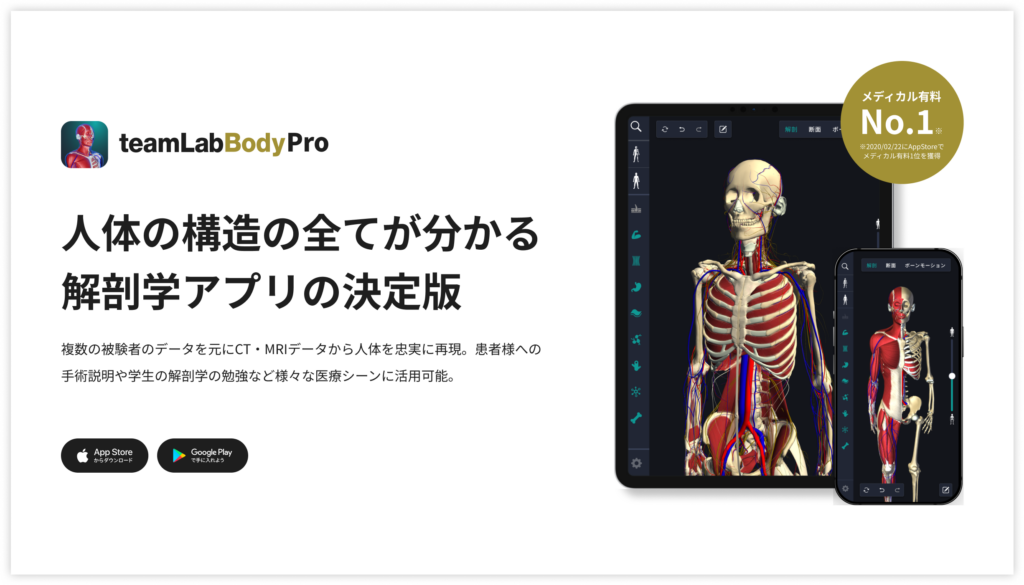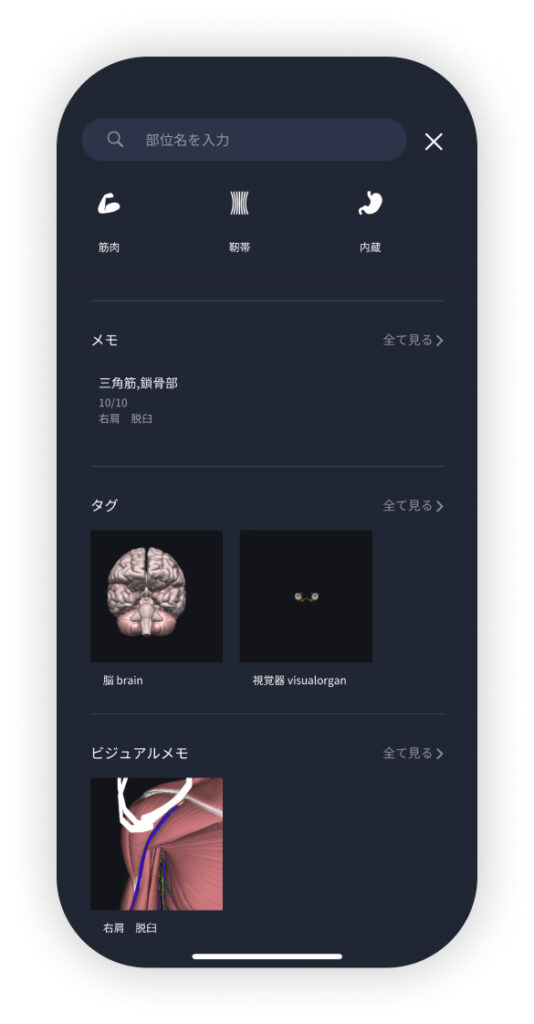beginning
In this article, I will explain effective study methods, starting with knowledge of specialized parts in human anatomy.
In human anatomy, it is necessary not only to memorize the names of various organs, muscles, and bones, but also to remember where they are located in the body. Therefore, it is necessary to learn as efficiently as possible.
I hope you will deepen your understanding even a little by reading this article and using the app.
Now, I'll explain the details about the “yellow ligament” and how to study human anatomy.
teamLab Body Pro Free Download
A 3D anatomy app that shows all the structures of the human body
Download teamLab Body Pro here!

What is the yellow ligament?
The anatomy application allows you to view a selection of anatomy 3D models. In this model, there are various observation methods such as surfaces, cross-sections, and nervous systems. This time, I'll explain using an anatomy application.
About yellow ligament

The yellow ligament is a ligament that connects the inside of the vertebrae (lamina disc) between the upper and lower vertebrae, and spans the entire spine from the cervical spine to the lumbar spine. What is the biggest characteristic of this ligamentyellowish tone rich in elastic fibersIt is derived from, and this is a big difference from other ligaments.
The yellow ligament plays a role like a “spring” that helps the spine recover from stretching (movement that bends the body), and contributes to achieving both stability and mobility between the vertebrae.
Also, since it forms part of the back wall of the vertebral canal,Function that protects the spinal cord and cauda equinaI also have it. Conditions such as “yellow ligament ossification” and “spinal canal stenosis,” in which the yellow ligament thickens due to aging or degeneration, narrows the spinal canal and compresses nerves are known.
Study points
Anatomical understanding: elastic structures within the spine
Since the yellow ligament is located between the vertebrae and vertebrae,Part of a group of ligaments on the posterior and medial surface of the spineI understand it as First, it is basic to check “which part of the vertebra is attached” with models and diagrams, and then learn relationships with other structures such as intervertebral joints, spines, and intervertebral discs. With the 3D anatomy application, it is possible to visualize the lamina disc and intuitively understand the running of the yellow ligament, so it is effective for visually capturing the structure. Also, since the yellow ligament is also part of the back wall of the vertebral canal, let's also keep track of the spatial positional relationship with the spinal cord.
Functional understanding: mobility and protection through elasticity
What are the characteristics of the yellow ligamentMainly elastic fibersIt means that it is. Whereas normal ligaments are mainly composed of collagen fibers, yellow ligaments have many elastic fibers, so they have “the power to naturally return to normal” when returning from trunk extension to flexion. In learning, you can experience the function of this ligament by being aware of the feeling of naturally returning to your original posture without doing anything after bending your body. Also, as the back wall of the spinal canal, it also has the role of protecting the spinal cord and nerve roots, so the clinical perspective deepens when considered in conjunction with “understanding the structure of the spinal canal.”
Practical application: essential for understanding spinal canal stenosis
Yellow ligaments are caused by aging or chronic stressThickening/ossificationIt's easy, especially thickening in the lower backspinal canal stenosisIt causes In clinical settings, nerve roots are compressed by this thickening, and lower back pain, lower limb numbness, and intermittent claudication may appear. Since thickening of the yellow ligament is an important finding even in diagnostic imaging (MRI and CT),Knowledge of position, thickness, and adjacent structuresis required. Also, for physical therapists and judo therapists, program design that is conscious of the load on this ligament is required during exercise therapy and posture guidance.
How to study human anatomy
I will explain specific study methods using human anatomy applications.
Check your past learning history and practice repeatedly
Here are the steps to check your anatomy learning history and practice iteratively effectively.
1. Check your learning history in the app
Reviewing your learning history with the application is an important step in effectively advancing anatomy learning. First, launch the app and go to the learning history section from the main menu. Many anatomy apps are designed to show your progress in the form of graphs and lists, so you can visually check which parts you've learned about and how much time you've spent.
By using this data, you can understand which areas you have strengths in and where you need to spend more time and effort. We also recommend using a dedicated tag or notebook function to mark areas you are particularly weak at or where you need to relearn. Regularly checking your learning history and looking back on past learning content will lead to efficient review and deepening understanding.
2.Make a plan for iterative learning
Making an efficient repetitive learning plan based on learning history is extremely effective in promoting knowledge retention. First, identify weak points and areas where you need to relearn. Next, arrange these study items into a weekly or monthly calendar and create a specific study schedule. By proceeding in a planned manner, you can learn each part evenly and avoid packing in a large amount of information at once.
Using a task management app or digital calendar to set study reminders is effective. Also, it's important to have the flexibility to regularly review progress and revise plans as needed. By having goals and proceeding with your studies in a planned manner, you can efficiently acquire anatomical knowledge.
3.Use 3D features to learn visually
By utilizing the 3D function, learning anatomy is easier to understand visually. The 3D model shows the structure of the human body three-dimensionally, and each part can be observed in detail. This makes it possible to intuitively grasp positional relationships between deep muscles and organs that are difficult to capture in a planar view. For example, you can learn even the smallest details by rotating specific muscles and bones and zooming in and out.
Also, there are many apps that have the function of displaying cross-sectional views of each part using a 3D model, which is useful for deepening understanding of internal structures. This diversity of visual information helps with memory retention and improves immediate responsiveness in tests and practice situations. By utilizing the 3D function and learning visually, you can learn anatomy knowledge more deeply and efficiently.
Use the memo function concretely

Make notes so you don't forget the things and points you've noticed while studying. The memo function can be used for different purposes, such as inputting text, saving images, and writing memos. Tag your notes to make them easier to review later.
Test your learning regularly in the form of quizzes
Regularly testing what you've learned in a quiz format is a very effective way to anchor your anatomy knowledge. Quiz-style tests help you objectively grasp your level of understanding and areas you lack while repeating knowledge.
For example, by using a learning app to conduct quizzes every specific period, you can reconfirm what you've learned and strengthen your memory. There are a wide range of quiz formats, such as multiple choice questions, fill-in-the-blank questions, and short answer questions, and each helps understanding from a different angle and develops the ability to utilize various types of knowledge.
Get feedback
If possible, get feedback from other learners and experts. It helps you find your own gaps in understanding and areas for improvement. You can also keep yourself motivated to learn by regularly testing yourself. Feeling a sense of accomplishment and progress increases motivation for continuous learning.
summary
This time, I explained how to study about the “yellow ligament” using an application!
Thank you for reading this far.
I would be happy if reading this article helped you learn about anatomy.
Learning is a long, never-ending journey, but I sincerely wish you all the best. Let's continue to study together and work hard for the national exam!
Please look forward to the next blog.
teamLab Body Pro Free Download
A 3D anatomy app that shows all the structures of the human body
Download teamLab Body Pro here!





